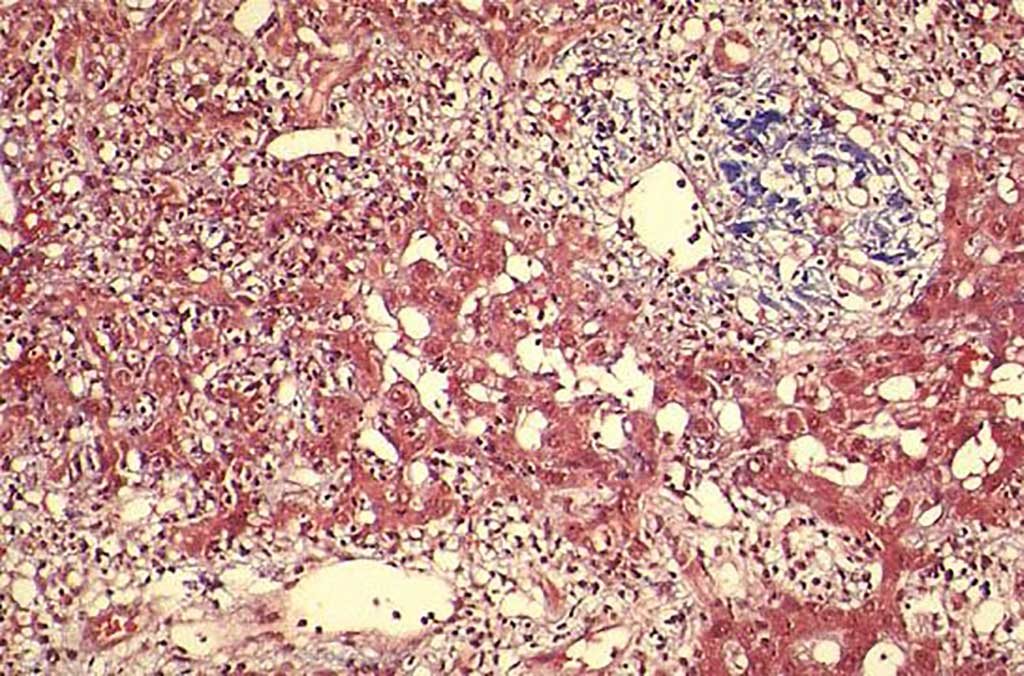HDL-Cholesterol Predicts Survival in Cirrhotic Patients with Gastrointestinal Bleeding
By LabMedica International staff writers
Posted on 10 Dec 2020
Liver cirrhosis is an important cause of morbidity and mortality as a consequence of continuous liver injuries. Acute gastrointestinal bleeding is a serious complication and critical clinical event in cirrhotic patients. Hepatitis B virus (HBV) is the leading cause of liver cirrhosis in China.Posted on 10 Dec 2020
Since the liver plays a crucial role in cholesterol homeostasis, hypercholesterolemia often occurs in patients with chronic liver diseases. The decrease in serum levels of lipids and lipoproteins is highly prevalent in cirrhotic patients, with a prevalence that increases in parallel with the disease severity.

Image: Histopathology of a cirrhotic liver. High-density lipoprotein cholesterol predicts survival in cirrhotic patients with acute gastrointestinal bleeding (Photo courtesy of Loyola University Chicago).
Infectious disease specialists at the Peking University First Hospital (Beijing, China) evaluated from January 2008 to December 2015, consecutive cirrhotic patients with acute gastrointestinal bleeding who were randomly divided into the derivation (n = 629) and validation (n = 314) cohorts. Liver cirrhosis was confirmed either by liver biopsy or by clinical presentations, routine liver function tests and medical imaging techniques. A logistic regression model was established to confirm the association between lipoprotein cholesterol and mortality. Routine biochemical tests were performed in the hospital laboratory. Lipid profiles include triglyceride, cholesterol, high-density lipoprotein cholesterol (HDL-C) and low-density lipoprotein cholesterol (LDL-C).
The investigators reported that on ROC analysis, HDL-C showed excellent diagnostic accuracy for six-week mortality, with an area under the receiver operating characteristic curves (AUROC) of 0.847 (95% CI 0.789–0.905). The best cut-off value of HDL-C was 0.54 mmol/L, with a sensitivity of 85.1% and specificity of 74.2%. The laboratory variables significantly associated with 6-week mortality in the univariate analysis were as follows: hepatocellular carcinoma (HCC), packed red blood cells (PRBC) transfusion, hemoglobin (HGB), total leukocyte count (WBC), alanine aminotransferase (ALT), serum sodium (Na), total bilirubin (TBIL), albumin (ALB), cholesterol, HDL-C, LDL-C, serum creatinine (Scr), international normalized ratio (INR), fibrinogen (FIB). Multivariate logistic regression analyses showed that TBIL, HDL-C, Na, and HGB were independently associated with six-week mortality.
The authors concluded that HDL-C is a potential indicator for the prognosis of patients with cirrhosis and acute gastrointestinal bleeding. The new algorithm based on HDL-C allowed an accurate predictive assessment of 6-week mortality after bleeding attack. The study was published on November 16, 2020 in the journal BMC Gastroenterology.
Related Links:
Peking University First Hospital







 Analyzer.jpg)





